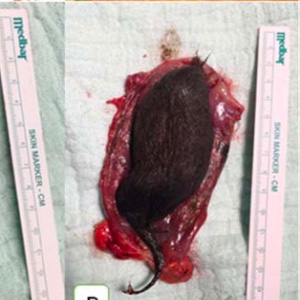The esophageal rapunzel syndrome: a case of a trichobezoar in the esophagus

Accepted: 18 February 2023
All claims expressed in this article are solely those of the authors and do not necessarily represent those of their affiliated organizations, or those of the publisher, the editors and the reviewers. Any product that may be evaluated in this article or claim that may be made by its manufacturer is not guaranteed or endorsed by the publisher.
Rapunzel syndrome is a form of trichobezoar, a rare form of bezoar, especially seen in individuals with hair pulling (trichotillomania) and hair eating (tricophagia) habits, that extends from the pylorus into to the duodenum, jejunum and even the colon. We report the case of a 37-year-old woman with a trichobezoar in the esophagus, causing esophageal rupture that required an urgent surgical intervention.
Kajal P, Bhutani N, Tyagi N, et al. Trichobezoar with and without Rapunzel Syndrome in paediatric population: a case series from a tertiary care centre of Northern India. Int J Surg Case Rep 2017;40:23-6. DOI: https://doi.org/10.1016/j.ijscr.2017.08.060
Vaughn ED, Sawyers JL, Scott HW: The Rapunzel syndrome: an unusual complication of intestinal bezoar. Surgery 1968;63:339.
Meier CM, Furtwaengler R. Trichophagia: Rapunzel syndrome in a 7-year-old girl. J Pediatr 2015;166:497. DOI: https://doi.org/10.1016/j.jpeds.2014.10.040
Lyons D. Large gastric trichobezoar causing failure to thrive and iron defi ciency anaemia in an adolescent girl: a case report emphasising the imaging findings and review of the literature. BJR 2019;5:20180080. DOI: https://doi.org/10.1259/bjrcr.20180080
Diefenbach GJ, Reitman D, Williamson DA. Trichotillomania: A challenge to research and practice. Clin Psychol Rev 2000;20:289-30. DOI: https://doi.org/10.1016/S0272-7358(98)00083-X
Carr JR, Sholevar EH, Baron DA. Trichotillomania and trichobezoar: A clinical practice insight with report of illustrative case. J Am Osteopath Assoc 2006;106:647–52.
Pérez E, Sántana JR, García G, et al. Gastric perforation due to trichobezoar in an adult (Rapunzel syndrome). Cir Esp 2005;78:268-70. DOI: https://doi.org/10.1016/S0009-739X(05)70931-3
Duke DC, Keeley ML, Geffken GR, Storch EA. Trichotillomania: A current review. Clin Psychol Rev 2010;30:181-93. DOI: https://doi.org/10.1016/j.cpr.2009.10.008
Bouwer C, Stein DJ. Richobezoars in trichotillomania: Case report and literature overview. Psychosom Med 1998;60:658–60. DOI: https://doi.org/10.1097/00006842-199809000-00025
Sehgal VN, Srivastava G. Trichotillomania +/- trichobezoar: Revisited. J Eur Acad Dermatol Venereol 2006;20:911–5.
Coulter R, Antony MT, Bhuta P, Memon MA. Large gastric trichobezoar in a normal healthy woman: Case report and review of pertinent literature. South Med J 2005;98:1042-4. DOI: https://doi.org/10.1097/01.smj.0000182175.55032.4a
Malpani A, Ramani SK, Wolverson MK. Role of sonography in trichobezoars. J Ultrasound Med 1988;7:661-3. DOI: https://doi.org/10.7863/jum.1988.7.12.661
Kılınçaslan H, Aydoğdu I, Küçükkoç M, et al. Approach to Trichobezoar Cases in Children: Literature Review. Bezmialem Sci 2014;1:26-30. DOI: https://doi.org/10.14235/bs.2014.270
Newman B, Girdany BR. Gastric trichobezoars — sonographic and computed tomographic appearance. Pediatr Radiol 1990;20:526-7. DOI: https://doi.org/10.1007/BF02011382
Naik S, Gupta V, et al. Rapunzel syndrome reviewed and redefined. Dig Surg 2007;24:157-61. DOI: https://doi.org/10.1159/000102098
Eng K, Kay M. Gastrointestinal bezoars: history and current treatment paradigms. Gastroenterol Hepatol (NY) 2012;8:776-8.
Phillips MR, Zaheer S, Grugas GT. Gastric trichobezoar: case report and literature review. Mayo Clin Proc 1998;737:653-6. DOI: https://doi.org/10.1016/S0025-6196(11)64889-1
Fallon SC, Slater BJ, Larimer EL, et al. The surgical management of Rapunzel syndrome: a case series and literature review. J Pediatr Surg 2013;48:830-4. DOI: https://doi.org/10.1016/j.jpedsurg.2012.07.046
Mohammed AA, Arif SH, Qadir RH, et al. Surgical extraction of a giant trichobezoar: A rare presentation. Int J Case Rep Images 2018;9. DOI: https://doi.org/10.5348/100929Z01AM2018CR
Kanetaka K, Azuma T, Ito S, et al. Two-channel method for retrieval of gastric trichobezoar: Report of a case. J Pediatr Surg 2003;38:e7. DOI: https://doi.org/10.1053/jpsu.2003.50067
Gorter RR, Kneepkens CM, Mattens EC, et al. Management of trichobezoar: case report and literature review. Pediatr Surg Int 2010;26:457-3. DOI: https://doi.org/10.1007/s00383-010-2570-0
Copyright (c) 2023 the Author(s)

This work is licensed under a Creative Commons Attribution-NonCommercial 4.0 International License.
PAGEPress has chosen to apply the Creative Commons Attribution NonCommercial 4.0 International License (CC BY-NC 4.0) to all manuscripts to be published.


 https://doi.org/10.4081/ecj.2023.11145
https://doi.org/10.4081/ecj.2023.11145







